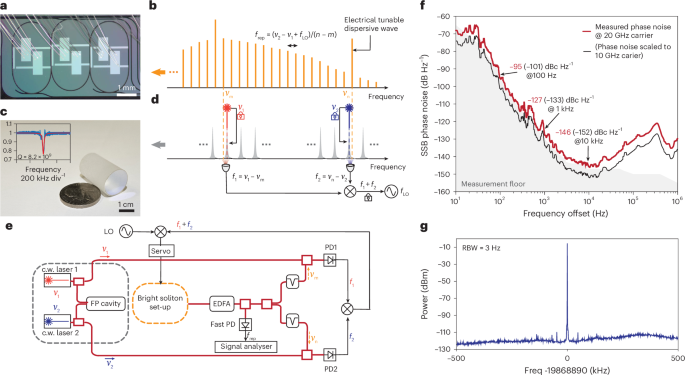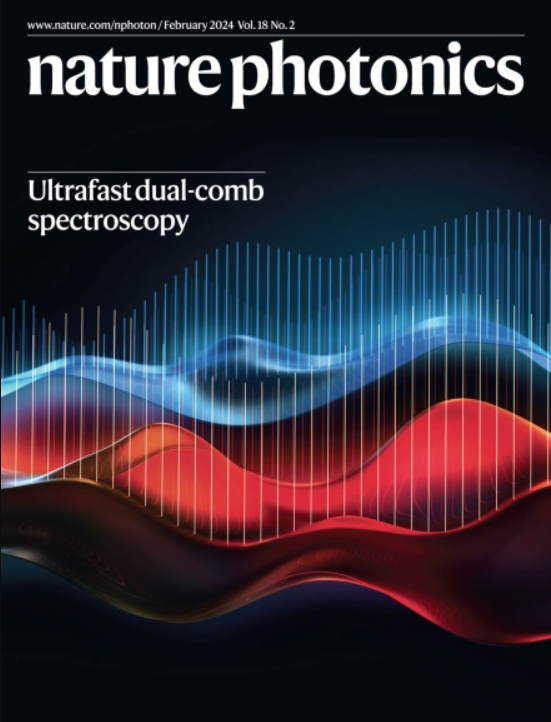色散波捷变光分频
IF 32.9
1区 物理与天体物理
Q1 OPTICS
引用次数: 0
摘要
谐振系统在光学领域(光腔和原子跃迁)的显著频率稳定性可以利用光学分频在电子可访问的频率尺度上。这种能力是革命性的技术跨越时间保持高性能的电子信号源。该技术的一种称为两点光分频(2P-OFD)的版本被证明有利于应用于高性能信号源。在2P-OFD中,光学腔固定由频率梳线定义的两个频谱端点。梳子无需自引用,大大简化了系统架构,降低了功耗要求。在这里,使用微梳演示了具有创纪录低相位噪声的2P-OFD微波信号源。这一进展的关键是由微梳孤子发射的频率敏捷单模色散波定义的频谱端点。此外,系统的频率参考是一个紧凑的全固态光腔,具有创纪录的Q因子。该系统的混合封装版本提供了出色的长期稳定性。研究结果将基于可积微梳的信号源推进到更大的微波源的性能领域。本文章由计算机程序翻译,如有差异,请以英文原文为准。


Dispersive-wave-agile optical frequency division
The remarkable frequency stability of resonant systems in the optical domain (optical cavities and atomic transitions) can be harnessed at frequency scales accessible by electronics using optical frequency division. This capability is revolutionizing technologies spanning time keeping to high-performance electrical signal sources. A version of the technique called two-point optical frequency division (2P-OFD) is proving advantageous for application to high-performance signal sources. In 2P-OFD, an optical cavity anchors two spectral endpoints defined by lines of a frequency comb. The comb need not be self-referenced, which greatly simplifies the system architecture and reduces power requirements. Here, a 2P-OFD microwave signal source is demonstrated with record-low phase noise using a microcomb. Key to this advance is a spectral endpoint defined by a frequency-agile single-mode dispersive wave that is emitted by the microcomb soliton. Moreover, the system frequency reference is a compact all-solid-state optical cavity with a record Q factor. A hybridly packaged version of the system offers excellent longer term stability. The results advance integrable microcomb-based signal sources into the performance realm of much larger microwave sources. Using two-point optical frequency division based on a frequency-agile single-mode dispersive wave, a microwave signal source with record-low phase noise using a microcomb is demonstrated, offering over tenfold lower phase noise than state-of-the-art approaches.
求助全文
通过发布文献求助,成功后即可免费获取论文全文。
去求助
来源期刊

Nature Photonics
物理-光学
CiteScore
54.20
自引率
1.70%
发文量
158
审稿时长
12 months
期刊介绍:
Nature Photonics is a monthly journal dedicated to the scientific study and application of light, known as Photonics. It publishes top-quality, peer-reviewed research across all areas of light generation, manipulation, and detection.
The journal encompasses research into the fundamental properties of light and its interactions with matter, as well as the latest developments in optoelectronic devices and emerging photonics applications. Topics covered include lasers, LEDs, imaging, detectors, optoelectronic devices, quantum optics, biophotonics, optical data storage, spectroscopy, fiber optics, solar energy, displays, terahertz technology, nonlinear optics, plasmonics, nanophotonics, and X-rays.
In addition to research papers and review articles summarizing scientific findings in optoelectronics, Nature Photonics also features News and Views pieces and research highlights. It uniquely includes articles on the business aspects of the industry, such as technology commercialization and market analysis, offering a comprehensive perspective on the field.
 求助内容:
求助内容: 应助结果提醒方式:
应助结果提醒方式:


